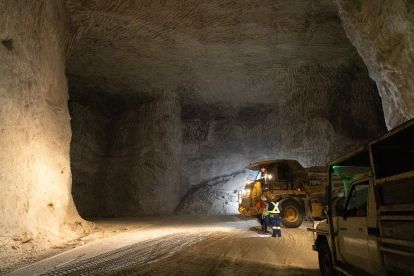
Share
It’s still hot and sunny outside, but workers at the Windsor Salt mine in Pugwash, Nova Scotia think about road salt all year round. Unifor Atlantic Regional Director Jennifer Murray got to experience the deeps with Local 823, travelling 830 feet down the main shaft to stand in the expansive rooms and roads, called drifts, inside the mine.
“I am so thankful to Local President Robert McKellar for inviting me into his one-of-a-kind workplace,” said Murray. “My jaw was on the floor the whole time, seeing the beauty of the salt walls and trying to wrap my mind around all the work that goes into every aspect of what they do.”
The salt mine has been in business since 1959 in the small community along the Northumberland Shore. The distinctive black and bright yellow striped bags of Safe-T-Salt available in hardware and grocery stores across the Atlantic provinces are mined and packaged at the Windsor Salt mine.
The mine is what is referred to as a room and pillar mine, where material is extracted across a horizontal plane, creating a network of roadways and rooms. Pillars are left between rooms to act as a support structure, like a skeleton, between the layers. There are approximately 200 kms of total mined drifts that are approximately 16 meters wide with 10-meter ceilings for a first cut or 20 meters high for second cuts.
Murray descended the main shaft elevator that can carry 11 people tightly packed. When not transporting people up and down the shaft, the elevator hauls “muck”, or unprocessed salt and rock, up to the above-ground facility to be properly tested, brined, sized and packaged into ready-to-sell bags of road salt.
That shaft is also what workers use to transport every tool and vehicle needed for their operation, so even their large vehicles must be disassembled enough to fit pieces down the narrow shaft where they are then welded back together in the underground maintenance shop. Only the tires go down whole.
“Walking beside these huge industrial mining vehicles knowing that Unifor members on the maintenance team have broken them apart and then puzzle-pieced them back together was just mind-blowing,” said Murray. “There’s an incredible amount of skill and creativity needed to work in such an environment.”
Touring the above-ground facility, Murray quickly understood how practiced the packaging worker was once she tried her hand at the line. The worker demonstrated by grabbing an empty salt bag, opening it, and slipping it up onto the filler where 20 kgs of road salt falls in one sudden dump. While one bag is filling, the worker grabs the open bag flaps on the next bag moving along a conveyor, pulls them together, pushes the air down and then angles the top so it will file perfectly into the sealer. This fluid motion happens all at once, taking seconds to fill one bag and get the next ready to seal.
At the other side of the sealer, a conveyor of bags ready for store shelves are grabbed by two workers and placed onto pallets.
“I’ll be thinking of these Unifor members this winter each time I salt my driveway and see the highway crews out salting the roads before a storm,” said Murray. “Thank you for giving me a chance to see your workplace and for all the hard work you do each day to bring an essential product to the shelves.”
View photos of the tour on the Unifor Facebook page.




